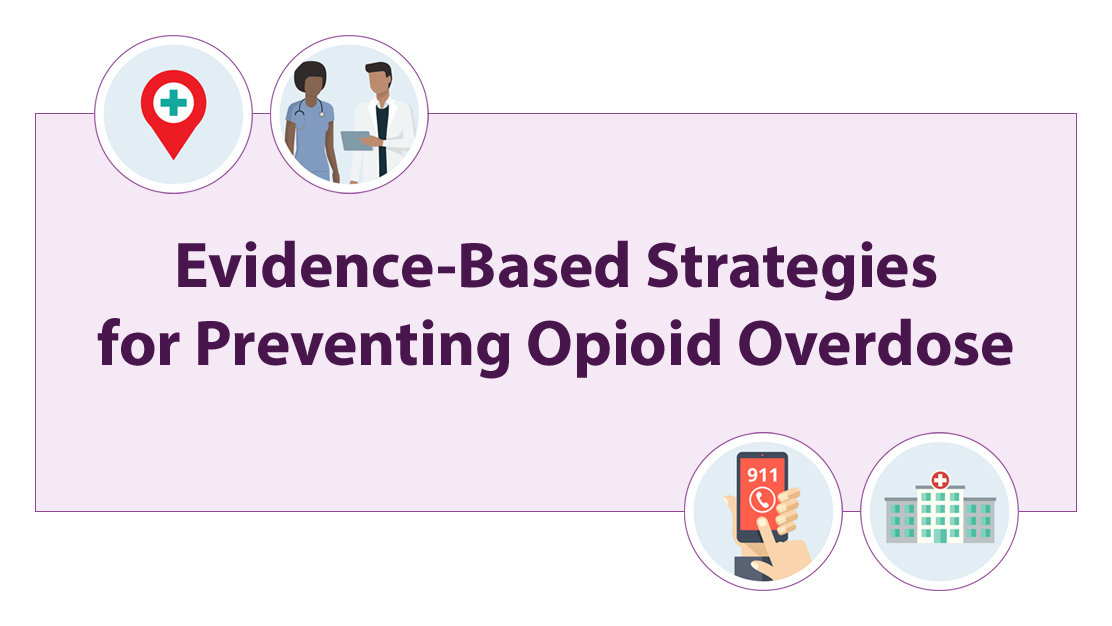Evidence-Based Strategies for Preventing Opioid Overdose: What’s Working in the United States

There are strategies that can assist community leaders, local and regional organizers, non-profit groups, law enforcement, public health, and members of the public in understanding and navigating effective ways to prevent opioid overdose in their communities. Use this information as a reference for evidence-based practices that have been successfully implemented in the U.S.
Evidence-Based Strategies for Preventing Opioid Overdose (PDF – 40 pages)
Guiding Principles
There are overarching principles that serve as a guide for the design and implementation of effective overdose prevention strategies. The four guiding principles below are lessons learned from previous public health emergencies.
- Know your epidemic, know your response.
Opioid overdose is driven by many different mechanisms and human experiences, and people may follow a variety of paths toward opioid misuse and overdose. The realities faced by people who use drugs may be common across regions or vary within tight social groups. - Make collaboration your strategy.
Effectively responding to the opioid overdose epidemic requires that all partners be at the table. Make collaboration your strategy by ensuring that all community entities are able to fulfill their necessary roles. - Nothing about us without us.
Prevention strategies need to take into account the realities, experiences, and perspectives of those at risk of overdose. Those affected by opioid use and overdose risk should be involved in developing the solutions. The design, implementation, and evaluation of interventions help assure those efforts are responsive to what’s happening in the local community and can achieve the desired goals. - Meet people where they are.
The guiding principle of “meeting people where they are” means more than showing compassion or tolerance to people in crisis. This principle also asks us to acknowledge that all people we meet are at different stages of behavior change. Recognizing these stages helps set reasonable expectations for interacting with people.
Successful Strategies for Preventing Opioid Overdose
The ten evidence-based strategies highlighted below are actions that states and jurisdictions can take today to prevent overdoses tomorrow.
- Targeted Naloxone Distribution
- Medication-Assisted Treatment (MAT1)
- Academic Detailing
- Eliminating Prior-Authorization Requirements for Medications for Opioid Use Disorder
- Screening for Fentanyl in Routine Clinical Toxicology Testing
- 911 Good Samaritan Laws
- Naloxone Distribution in Treatment Centers and Criminal Justice Settings
- MAT1 in Criminal Justice Settings and Upon Release
- Initiating Buprenorphine-based MAT in Emergency Departments
- Syringe Services Programs
- Targeted Naloxone Distribution
Naloxone – a non-addictive, life-saving drug that can reverse the effects of an opioid overdose when administered in time. Targeted naloxone distribution programs seek to train and equip individuals who are most likely to encounter or witness an overdose—especially people who use drugs and first responders— with naloxone kits, which they can use in an emergency to save a life. - Medication-Assisted Treatment (MAT) and Medication for Opioid Use Disorder (MOUD)
MAT is a proven treatment for opioid use disorder. The backbone of this treatment is FDA approved medications. Methadone and buprenorphine activate opioid receptors in the brain, preventing painful opioid withdrawal symptoms without causing euphoria; naltrexone blocks the effects of opioids. - Academic Detailing
Academic detailing consists of structured visits to healthcare providers by trained professionals. They provide tailored training and technical assistance, helping healthcare providers use best practices. - 911 Good Samaritan Laws
The scope of 911 Good Samaritan Laws varies across U.S. states, but each is written with the goal of reducing barriers to calling 911 in the event of an overdose. This type of legislation may provide overdose victims and/or overdose bystanders with limited immunity from drug-related criminal charges and other criminal or judicial consequences that may otherwise result from calling first responders to the scene. - Syringe Services Programs
Syringe services programs (SSPs) are community-based prevention programs that can provide a range of services, including linkage to substance use disorder treatment; access to and disposal of sterile syringes and injection equipment; testing; treatment for infectious diseases; and linkage to medical, mental health, and social services.
See the full list of strategies in CDC’s Evidence-Based Strategies for Preventing Opioid Overdose (PDF – 40 page). Each featured strategy includes why the strategy works, when it works best, a trailblazer example, and supporting research.
Establishing Peer Support Services for Overdose Response: A Toolkit for Health Departments supports the implementation of peer support services (PSS) within overdose response and linkage-to-care initiatives. This toolkit includes resources, tools, actionable steps, and real-world examples informed by the latest research, subject matter experts, and experiences from diverse settings across the country. It is designed for audiences including local and state health departments and community partners. The National Council for Mental Wellbeing developed this toolkit with support from the Centers for Disease Control Prevention.
Overdose Response and Linkage to Care: A Roadmap for Health Departments highlights linkage-to-care activities across a range of health department services. The roadmap includes links to guidance from public health agencies, free training resources, sample forms and templates, and monitoring and evaluation metrics. The National Council for Mental Wellbeing developed this roadmap with support from the Centers for Disease Control and Prevention.

